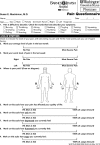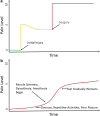The Role of the Peripheral Nerve Surgeon in the Treatment of Pain
- PMID: 30542905
- PMCID: PMC6361067
- DOI: 10.1007/s13311-018-00695-z
The Role of the Peripheral Nerve Surgeon in the Treatment of Pain
Abstract
Pain is a frequent cause of physician visits. Many physicians find these patients challenging because they often have complicated histories, emotional comorbidities, confusing examinations, difficult problems to fix, and the possibility of factitious complaints for attention or narcotic pain medications. As a result, many patients are lumped into the category of chronic, centralized pain and relegated to pain management. However, recent literature suggests that surgical management of carefully diagnosed generators of pain can greatly reduce patients' pain and narcotic requirements. This article reviews recent literature on surgical management of pain and four specific sources of chronic pain amenable to surgical treatment: painful neuroma, nerve compression, myofascial/musculoskeletal pain, and complex regional pain syndrome type II.
Keywords: Causalgia; Chronic pain; Complex regional pain syndromes; Hyperalgesia; Myofascial pain syndromes; Nerve compression; Neuralgia; Neuroma; Neurosurgery; Orthopedic surgery; Peripheral nerve injury; Plastic surgery; Reflex sympathetic dystrophy; Surgery.
Figures





Similar articles
-
Surgical Treatment of Upper Extremity Pain.Hand Clin. 2016 Feb;32(1):71-80. doi: 10.1016/j.hcl.2015.08.008. Hand Clin. 2016. PMID: 26611391 Review.
-
Somatic versus sympathetic mediated chronic limb pain. Experience and treatment options.Hand Clin. 1997 Aug;13(3):355-61. Hand Clin. 1997. PMID: 9279540 Review.
-
What is Operative? Conceptualizing Neuralgia: Neuroma, Compression Neuropathy, Painful Hyperalgesia, and Phantom Nerve Pain.J Hand Surg Glob Online. 2022 Jan 14;5(1):126-132. doi: 10.1016/j.jhsg.2021.11.004. eCollection 2023 Jan. J Hand Surg Glob Online. 2022. PMID: 36704371 Free PMC article. Review.
-
Evaluation of surgical treatment for neuropathic pain from neuroma in patients with injured peripheral nerves.J Neurosurg. 2018 Apr;128(4):1235-1240. doi: 10.3171/2017.1.JNS161778. Epub 2017 Jun 16. J Neurosurg. 2018. PMID: 28621630
-
[Operative treatment of painful neuromas].Ned Tijdschr Geneeskd. 2011;155(18):A2592. Ned Tijdschr Geneeskd. 2011. PMID: 22097392 Review. Dutch.
Cited by
-
Pain Relief after Surgical Decompression of the Distal Brachial Plexus.J Brachial Plex Peripher Nerve Inj. 2020 Oct 16;15(1):e22-e32. doi: 10.1055/s-0040-1716718. eCollection 2020 Jan. J Brachial Plex Peripher Nerve Inj. 2020. PMID: 33082844 Free PMC article.
-
A New Era for Surgical Neurotherapeutics.Neurotherapeutics. 2019 Jan;16(1):1-2. doi: 10.1007/s13311-019-00709-4. Neurotherapeutics. 2019. PMID: 30652252 Free PMC article. No abstract available.
-
Extradigital glomus tumour of the thigh causing 8 years of undiagnosed debilitating pain.BMJ Case Rep. 2022 Dec 19;15(12):e249869. doi: 10.1136/bcr-2022-249869. BMJ Case Rep. 2022. PMID: 36535730 Free PMC article.
-
Impact of Nerve Surgery on Opioid and Medication Use in Patients with Chronic Nerve Injuries.Plast Reconstr Surg Glob Open. 2021 Sep 7;9(9):e3789. doi: 10.1097/GOX.0000000000003789. eCollection 2021 Sep. Plast Reconstr Surg Glob Open. 2021. PMID: 34513538 Free PMC article.
-
The Peripheral Nerve Surgeon's Role in the Management of Neuropathic Pain.Plast Reconstr Surg Glob Open. 2023 May 19;11(5):e5005. doi: 10.1097/GOX.0000000000005005. eCollection 2023 May. Plast Reconstr Surg Glob Open. 2023. PMID: 37360238 Free PMC article.
References
-
- Gatchel RJ, Reuben DB, Dagenais S, Turk DC, Chou R, Hershey AD, et al. Research Agenda for the Prevention of Pain and Its Impact: Report of the Work Group on the Prevention of Acute and Chronic Pain of the Federal Pain Research Strategy. J Pain. 2018;19(8):837–51. doi: 10.1016/j.jpain.2018.02.015. - DOI - PubMed
Publication types
MeSH terms
Grants and funding
LinkOut - more resources
Full Text Sources
Medical
Research Materials

